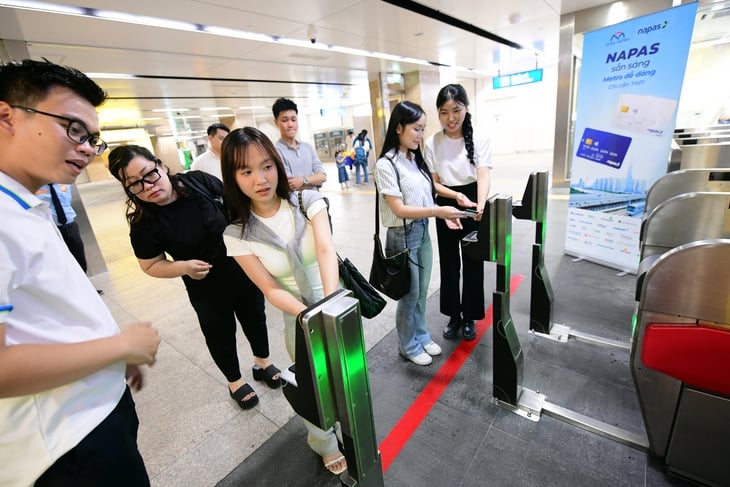
People use Napas cards to travel on Ben Thanh - Suoi Tien metro - Photo: QUANG DINH
"Cashless" is becoming an inevitable trend with the increasingly deep participation of banks in the field of electronic payments, bringing practical benefits to people of all ages and professions.
Go to the bank app, pay, pay taxes: 1 - 2 seconds and it's done
Ms. Le Phuong Linh (Cau Giay District, Hanoi) said that for over a year, all taxes such as business household tax, non- agricultural land use tax, motorbike registration fee or tuition for her children have been paid through her bank account.
"Just a few steps on the app, within 1-2 minutes, no more queuing at the treasury or bank like before," she shared.
The school where Linh's child studied used to collect tuition in cash, and parents had to come and pay in person. For the past two years, each student has been given an identification code. Just enter this code into the NH app and the system will automatically display full information: full name, class, school and tuition amount.
"I can pay from anywhere, anytime, very convenient. Obviously, cashless payment is extremely convenient and easy, there is no confusion," said Ms. Linh.
In Ho Chi Minh City, Ms. Kim Anh (Binh Thanh District) said that paying tuition fees is more convenient when the school prints QR codes on tuition notices. "Just scan the code, all information is automatically filled in the app, I just need to confirm payment," she said.
Not onlyeducation , many public services are also being transformed strongly. Mr. Nguyen Van Thanh (Nam Tu Liem district, Hanoi) said that he recently made a passport through the National Public Service Portal. Previously, even though he declared online, he still had to go to the place to pay the fee. Now everything is done online, helping to save a significant amount of time.
In addition, daily services such as electricity, water, telephone payments... are also automated. Ms. Phan Hoai Thu ( Hai Phong ) shared: "I set up an automatic debit order through my account. On the 10th of every month, the system automatically deducts money, no more worries about late payment or service interruption."
Ms. Thu has just completed booking flights and hotels for her vacation at the end of the month. The interesting thing is that it's all on the NH app. "Not only is it convenient, but it also has a better price than booking directly," she said.
"Now when I go out, I only use my phone. From buying real estate, cars, to a cup of coffee or a parking ticket of a few thousand dong - everything can be paid for with a QR code. My wallet only holds cards and personal documents, I almost never use cash anymore," said Ms. Thu.
Business households can sell with peace of mind
For small traders and business people, Ms. Pham Thi Thinh (Hanoi), owner of a pho restaurant on Hai Ba Trung Street (Hanoi), said that currently 80-90% of customers pay without using cash. Of these, 100% of customers pay by QR code.
"Payment has never been more convenient for both sellers and customers. Customers open the bank app, scan the QR code to pay. Another convenience is that I don't have to check my account after each payment.
With the payment speaker provided by the bank for free, the transferred amount is announced by the speaker after just one second. Therefore, sellers can avoid wrong transfers or even fraud, and can do business with peace of mind," Ms. Thinh happily said.
Techcombank representative said that for small businesses, controlling cash flow and processing payments quickly and accurately are key factors determining success.
In fact, many small businesses have difficulty with traditional payments such as mentally adding up money, receiving cash payments... So in addition to wasting time, there are many cases where the payment amount is incorrect.
Sharing this view, SHB believes that the payment speaker has completely solved these limitations. The payment speaker is a powerful assistant for small traders and business households when helping sellers receive accurate and immediate notification of the transaction amount.
Sellers do not need to take screenshots or check accounts every time they receive money.
In the market, a series of banks such as Techcombank, SHB, VietinBank, Sacombank... have developed sales speakers - smart devices that announce transaction amounts by voice, supporting quick and accurate transaction notifications.
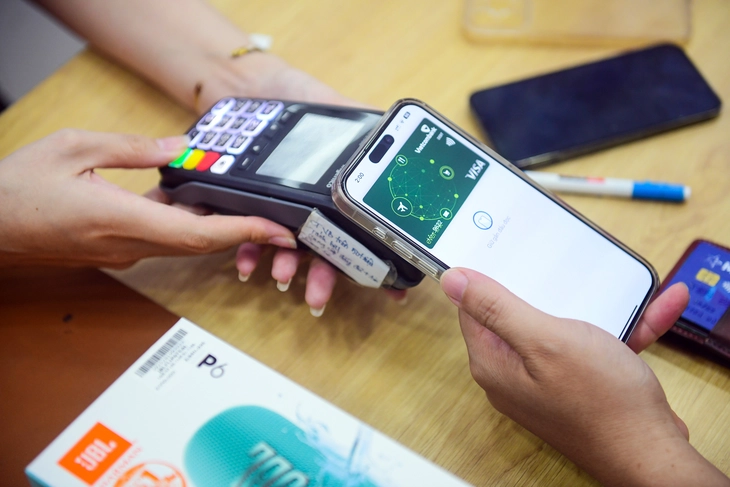
Customers pay cashless when shopping at a phone store in District 1, Ho Chi Minh City - Photo: QUANG DINH
More than 90% of transactions are via digital channels
HDBank representative said that 2024 marked the strong development of digital culture and digital business platforms. In 2024, up to 94% of individual customer transactions at HDBank were conducted on digital platforms.
Digital channels also contributed to 82% of new customers, the number of new customers exceeded 2 million customers. The number of transactions exceeded 100 million transactions, the deposit balance on digital channels grew exponentially.
Digitalization of customer journey, operating processes, big data analysis, application of robots and artificial intelligence in customer service are promoted, helping to improve productivity and optimize costs.
In 2024, the Galaxy Innovation Hub, a typical industrial transformation model developed by HDBank, was officially put into operation, not only marking a breakthrough in technological infrastructure, but also creating an innovation ecosystem to promote sustainable growth.
According to statistics from the State Bank, the number of personal payment accounts in Vietnam has reached more than 200 million. At many credit institutions, more than 90% of financial transactions are conducted through digital channels.
These figures reflect the great efforts and success of the entire banking industry in providing outstanding experiences and bringing practical benefits to service users.
Or at Agribank, the number of automatic transactions accounts for 91.97% of the total number of transactions. Currently, Agribank has nearly 20 million customers with payment deposit accounts, nearly 16 million customers using ATM cards, and about 15 million customers using payment services via mobile banking channels.
Mr. Nguyen Quoc Hung, General Secretary of the Banking Association, commented that the rate of adults with payment accounts has reached 87%, exceeding the target of 80% by 2025. The average annual growth rate of non-cash payments is more than 50%.
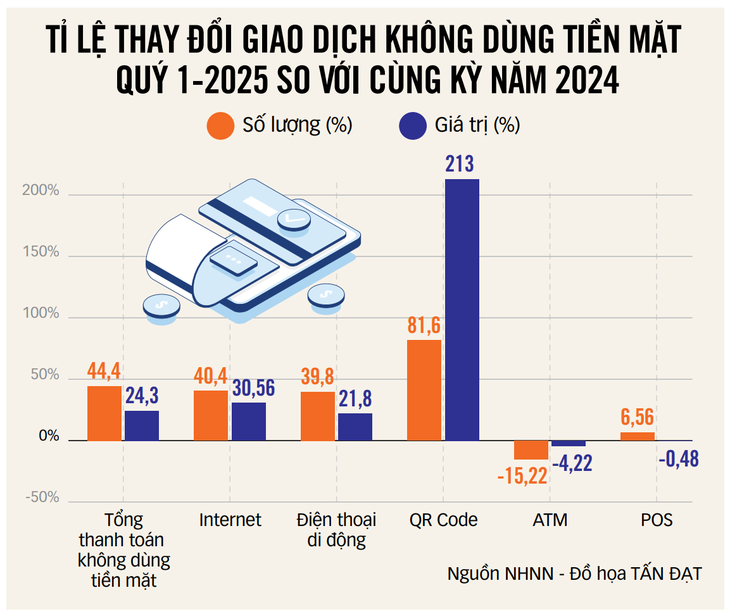
10 months, more than 108 million bank accounts are biometrically authenticated
After 10 months of implementing biometric authentication via chip-embedded citizen identification cards (CCCD) and VNeID application, the banking industry has successfully compared information of more than 108 million individual customer records, equivalent to more than 92% of the total number of accounts generating transactions on digital channels.
In addition, more than 530,000 institutional customer profiles, accounting for 41% of the total number of institutional accounts with electronic transactions, and about 20.9 million e-wallet accounts (accounting for 73.1%) have also had their biometric information compared with national population data.
The State Bank said that biometric authentication does not affect payment activities and is contributing to reducing fraud and loss of money in online transactions. To enhance security, the State Bank issued Circular No. 50/2024 dated October 31, 2024 on safety in providing online services, effective from January 1, 2025.
This authentication activity is within the framework of implementing Project 06 on developing population data applications, electronic identification and authentication, serving national digital transformation in the period 2022 - 2025, with a vision to 2030.
Credit institutions and payment intermediaries are actively participating, contributing to improving the safety of the financial system and user confidence.
High-tech crimes in payment activities are increasingly sophisticated
According to the State Bank, currently the work of preventing and combating crimes using high technology in electronic payments is facing some difficulties because high-tech crimes in payment activities are increasingly sophisticated, with complex tricks and rapid, continuous changes.
Bad guys often take advantage of the payment system for illegal activities such as gambling, fraud, tax evasion, drug trafficking, commercial fraud... which tend to increase.
However, payment is only the final step in the transaction process, while determining the legality of goods and services is under the authority of specialized management ministries.
Therefore, the banking industry cannot unilaterally verify and effectively prevent illegal transactions without close, regular and timely coordination from relevant agencies.
The State Bank also said that false information spreading on social networks about security risks in digital payments is negatively affecting people's trust in the banking system, while creating barriers to expanding cashless payments.
In addition, payment infrastructure is still mainly concentrated in urban areas, while rural, remote and isolated areas still lack access. Legal regulations on payment agent activities are also in the process of completion, requiring more time to guide and implement appropriately in practice.
Improving the effectiveness of high-tech crime prevention in the financial and banking sector needs to be implemented synchronously among sectors, in which the role of coordination and information connection is a key factor.
Cashless payments have caught up with many countries.
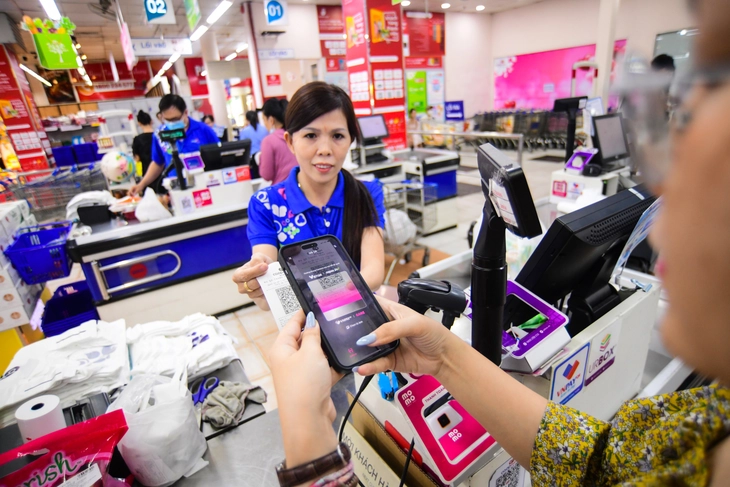
Customers pay by card at a supermarket in Ho Chi Minh City - Photo: T.PHUONG
Speaking with Tuoi Tre , Mr. Nguyen Hoang Long, Deputy General Director of Vietnam National Payment Corporation (NAPAS), commented as such.
* How do you evaluate the growth rate of cashless payments in Vietnam?
- About seven years ago, no one imagined that one day wallets would no longer be used for cash. Because for many people, especially young people, just going out with a smartphone and a certain balance in their account is enough to have breakfast, coffee, go to the market, take the bus, metro, watch movies, shop online...
The important thing is that payment by QR code, phone... has changed people's consumer behavior a lot. People can sit at home to buy goods online and pay online easily.
Digitizing accounts, making payments by QR and mobile phones has created convenience for users and contributed to promoting economic development.
Cashless payments in Vietnam have caught up with other countries in the Asian region such as China... In some ways, we are even ahead of developed countries. As in Europe, the payment infrastructure of many countries is still mainly based on physical cards and accounts.
* How do you predict the trend of payment methods in the future?
- In terms of trends, payment technology is shifting towards payment via accounts, especially via QR codes. Payment via QR codes linked to accounts is growing very rapidly and surpassing traditional payment methods such as bank cards and credit cards.
In countries like China, Vietnam, India, Thailand, payment transactions via accounts in the form of transfers and QR codes are much more popular than cards.
Regarding payment turnover via NAPAS, currently 95% of transactions are paid via accounts, only 5% are by card. If we add international cards, more than 90% of transactions are still via accounts.
This figure shows that card payments are in line with the consumer habits of people in Asian countries, including Vietnam. This is the payment trend in the coming years.
* In your opinion, why are account payments so dominant?
- When paying by card using the NH app, everyone uses it very easily and conveniently. In addition, paying by card is also safe because from July 1, face authentication is required for amounts over 10 million VND. International cards do not have such a complete layer of security protection.
From a security perspective, with the development of telecommunications technology infrastructure and digital infrastructure on mobile phones, payment by account is an inevitable trend.
Regional payment connectivity
* What role does NAPAS play in forming people's cashless payment habits?
- As a payment infrastructure provider, NAPAS plays an important role in forming people's cashless payment habits.
On the bank side, NAPAS connects card and account systems, deploys digital services such as Apple pay, Bank pay to digitize cards onto mobile phones. At the same time, NAPAS provides technical standards such as VietQR so that people and businesses can use accounts to make payments, instead of using cash or cards.
With the support of banks, NAPAS has successfully deployed the VietQR system not only domestically but also expanded to the international market. This system has now been connected in Laos, Thailand, Cambodia, Korea and soon China and Japan.
Thanks to that, Vietnamese people traveling in these countries can use domestic banks' mobile banking applications to scan QR codes to pay for goods and services without having to carry cash or use international cards.
This form is not only convenient and safe but also saves costs by avoiding high foreign exchange conversion fees.

Source: https://tuoitre.vn/nguoi-viet-bo-vi-cam-dien-thoai-2025052322133405.htm




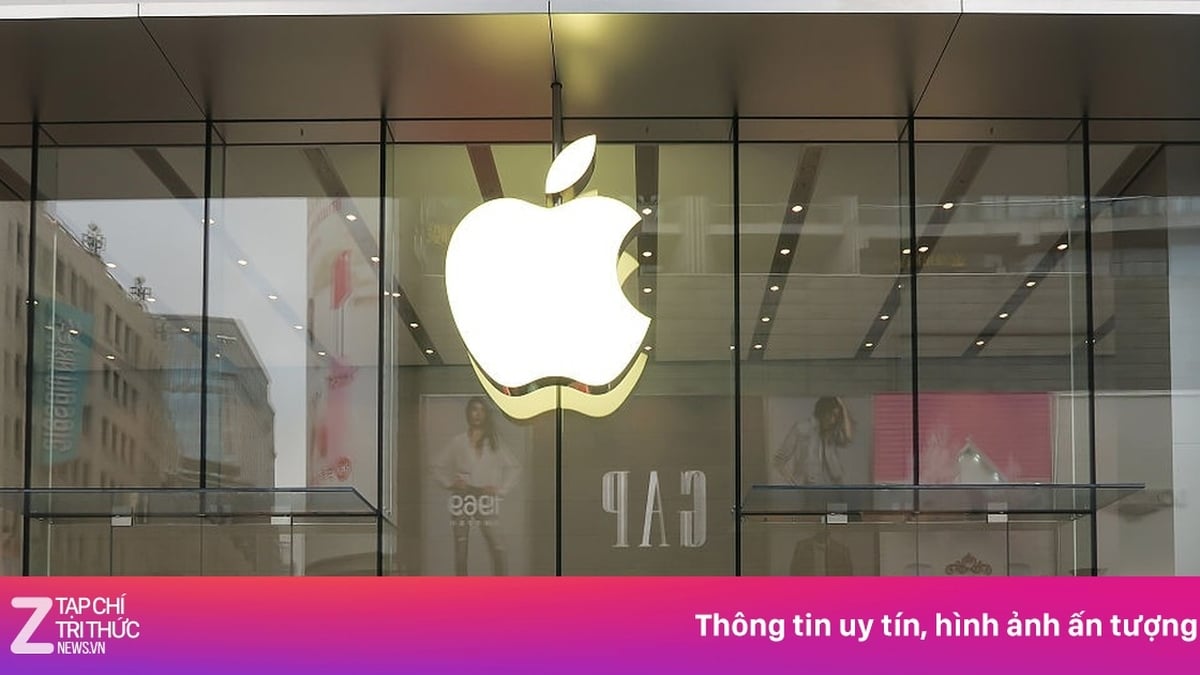
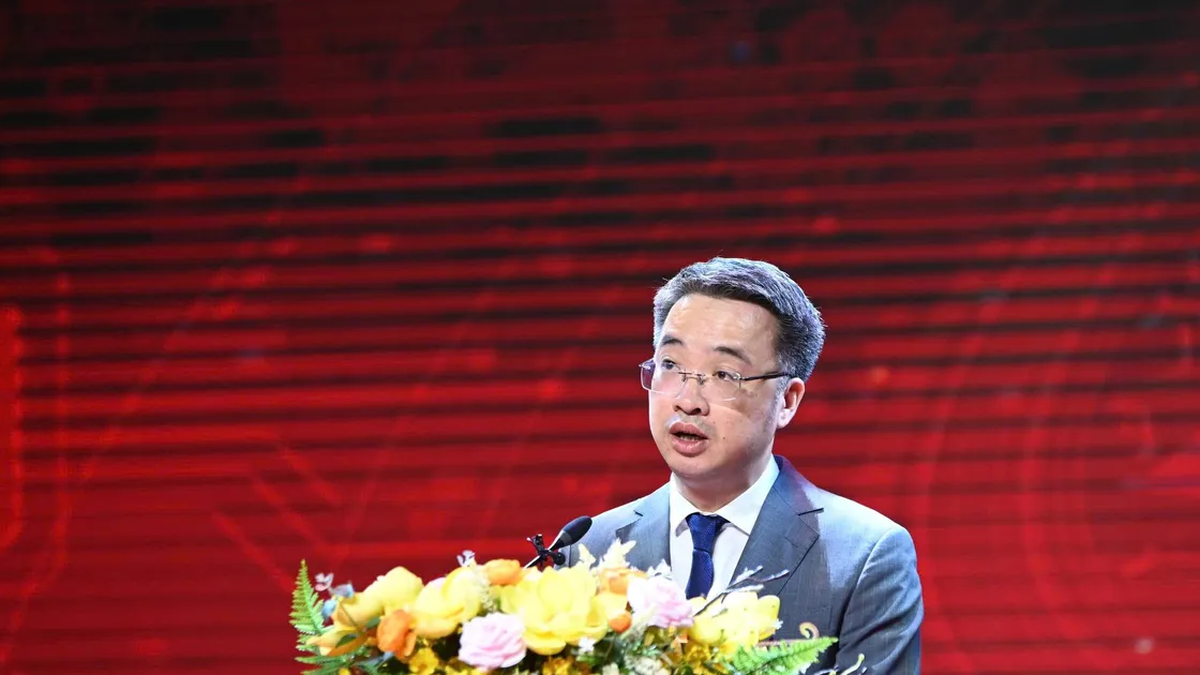

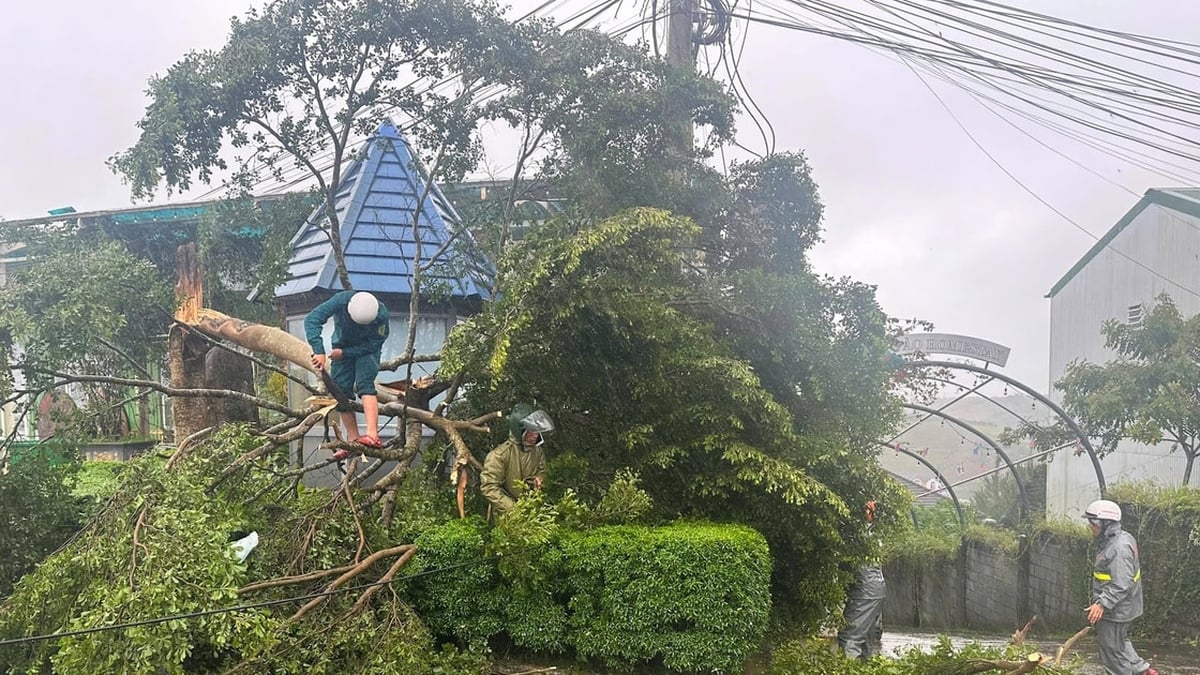

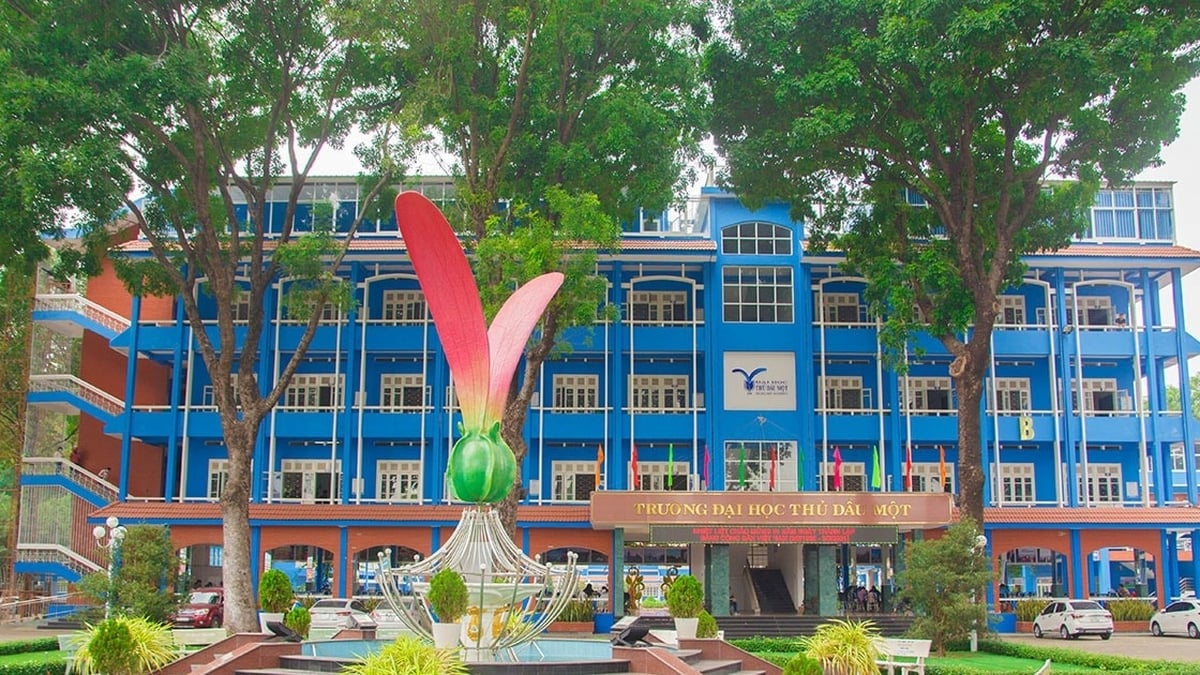
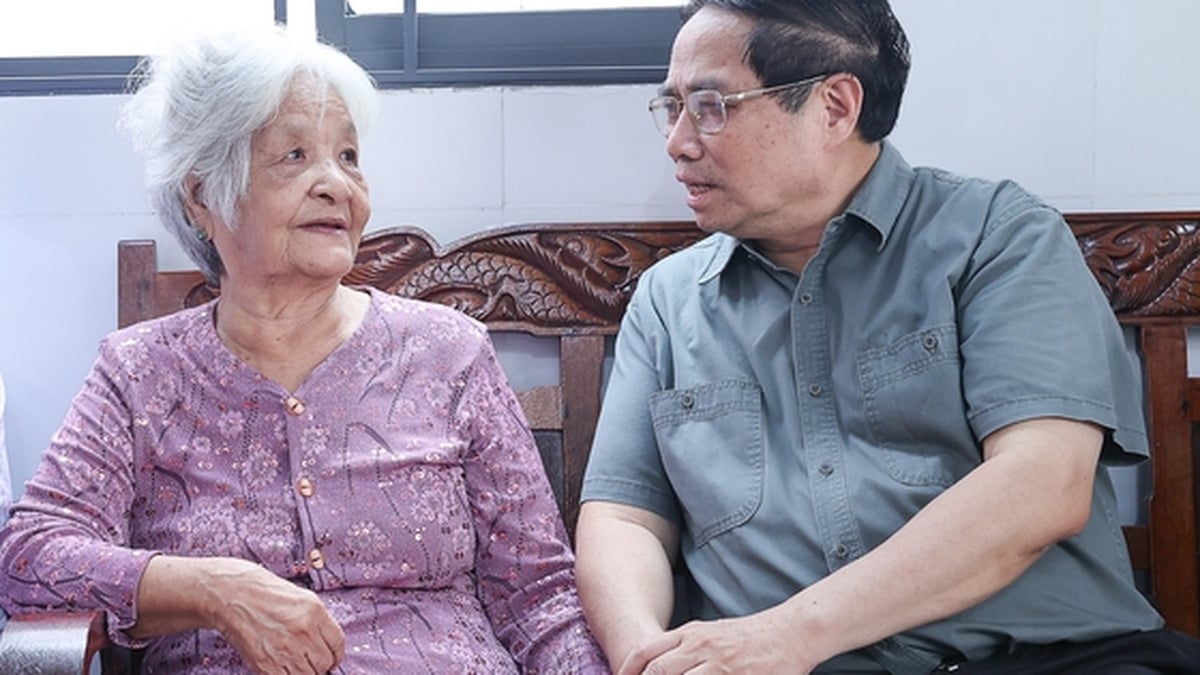
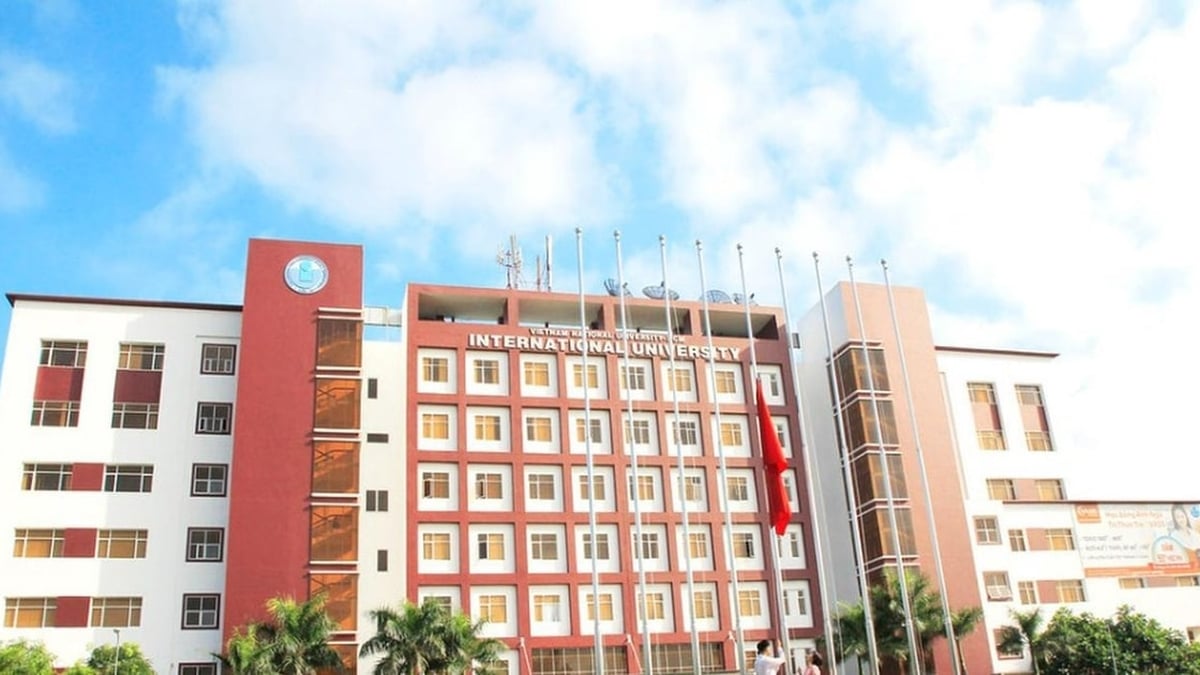













![[Photo] National Assembly Chairman Tran Thanh Man visits Vietnamese Heroic Mother Ta Thi Tran](https://vphoto.vietnam.vn/thumb/1200x675/vietnam/resource/IMAGE/2025/7/20/765c0bd057dd44ad83ab89fe0255b783)










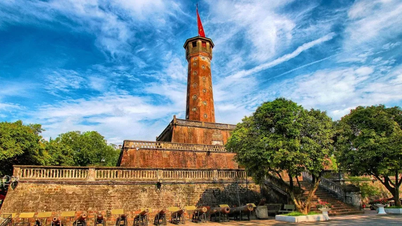

































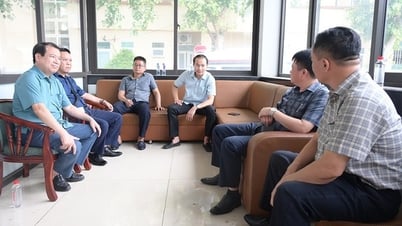


























Comment (0)